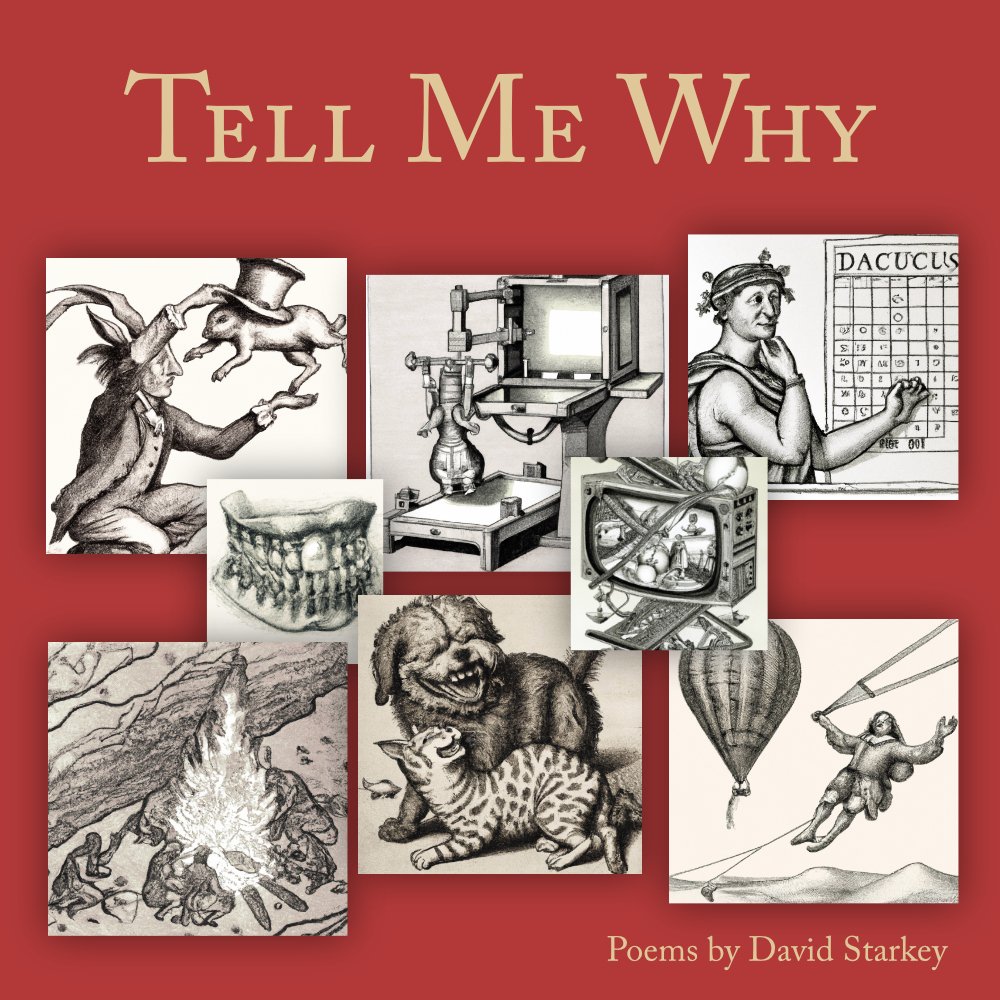Tell Me Why by David Starkey
Convincing, sometimes irreverent, poetic, and often downright fun, these question/answer poems offer a kind of “ . . . sleight-of-hand—scarves/rendered into a bouquet of flowers.” They remind us that poetry does offer answers to our questions, answers as beguiling and thought-provoking as anything we can ask of it. —Gail Wronsky
Convincing, sometimes irreverent, poetic, and often downright fun, these question/answer poems offer a kind of “ . . . sleight-of-hand—scarves/rendered into a bouquet of flowers.” They remind us that poetry does offer answers to our questions, answers as beguiling and thought-provoking as anything we can ask of it. —Gail Wronsky
Convincing, sometimes irreverent, poetic, and often downright fun, these question/answer poems offer a kind of “ . . . sleight-of-hand—scarves/rendered into a bouquet of flowers.” They remind us that poetry does offer answers to our questions, answers as beguiling and thought-provoking as anything we can ask of it. —Gail Wronsky
On March 31, 1964, The Beatles performed “Tell Me Why” before a paid audience (one that included the young Phil Collins) for inclusion in the film and album versions of A Hard Days Night. Just months later, Arkady Leokum published the first of his encyclopedic children’s books in the Tell Me Why series. Not really even a correspondence, let alone causation; there had already been two previous songs with that title, and a 1958 effort by Leokum with Scholastic Book Services. But Arkady was clearly riding a wave, one that he continued to ride through many other books in the series, culminating with The Big Book of Tell Me Why. Poet David Starkey was among the millions of readers, and as his quintets play across the pages of this wonderful book, the connections just keep multiplying. Leonardo, for example, appears in the first section sketching mushrooms, reappears to help answer “Why Are Some People Left-Handed,” then comes around again sketching helicopters and inventing cartoons. It’s a heady mixture that, like Neruda’s Bestiario raises as many questions as it answers. There will always be more “tell me whys,” as any parent or sibling will tell you, because each explanation always opens yet more inquisitors’ pathways. “We can’t see what it is we crave,” writes Starkey, and hence the endless quest for answers. Also like Neruda’s Bestiario, Starkey’s Tell Me Why arrives with a series of mysterious illustrations contributed by the artist Dall*E. Open AI insists that Dall*E can create art from descriptions in natural language. But has Open AI ever before scraped such language as “A window, a ladder. // A kind of polestar for the mariner / wandering from Non-Being into Being”?
—Aldon L. Nielsen, author of Back Pages, and Hard Gospel
Why do we ask questions? David Starkey’s delightful and quite informative new book of poems, Tell Me Why, a book in which every poem begins with a question, has some answers: because, perhaps, “[e]very living creature needs an idea/of its relation to earth in space,” or because we want to know “ . . . where to bury / the secret things we want no one to find.” Starkey is a magician here, providing poetic responses to questions like “What is a hummingbird?” (“The last guest to slip out of your dreams / every morning, the first one back in,” he writes.) Convincing, sometimes irreverent, poetic, and often downright fun, these question/answer poems offer a kind of “ . . . sleight-of-hand—scarves/rendered into a bouquet of flowers.” They remind us that poetry does offer answers to our questions, answers as beguiling and thought-provoking as anything we can ask of it.
—Gail Wronsky, author of Some Disenfranchised Evening
Image dense and delightfully irresponsible, David Starkey’s collaboration with AI in Tell Me Why bring us poems which are fresh, amusing, full of unexpected spinning leaps, both erudite and imaginative. Identities are as shifting and unstable as in the works of Ovid, and time (“turning, turning”) generates strangely playful fates, so that—for instance—“An egg finishes forming / when it hatches” and what emerges is “ready to gather experience like a girl / going into a henhouse with a basket.” But, be warned—or, rather, invited—the fun of these fast and formal poems leads easily into darker and deeper meditations: on the body, money, pain, the replacement of the real with the false… Indeed, as should be the case where poems are presented as answers / truths, there’s a strong bent in the book toward the subject of illusion, and our credulity. “Actually,” we learn here, “everything is the opposite / of what it seems.”
—Laura Mullen, author EtC and Complicated Grief
David Starkey served as Santa Barbara’s 2009-2011 Poet Laureate. Emeritus Professor and the Founding Director of the Creative Writing Program at Santa Barbara City College, he is currently Co-editor of Anacapa Review and The California Review of Books, and Publisher and Co-editor of Gunpowder Press. More than 500 of his poems have appeared in literary journals such as American Scholar, Georgia Review, Prairie Schooner and Southern Review; the most recent of his sixteen books of poetry are You, Caravaggio and The Moon Shall Not Give Her Light. His textbook with Bedford/St. Martin's, Creative Writing: Four Genres in Brief, is in its fourth edition and is one of the bestselling introductory creative writing textbooks in North America. (davidstarkey.net)
Book Information:
· Paperback: 102 pages
· Binding: Perfect-Bound
· Publisher: BlazeVOX [books]
· ISBN: 978-1-60964-497-0
$22
